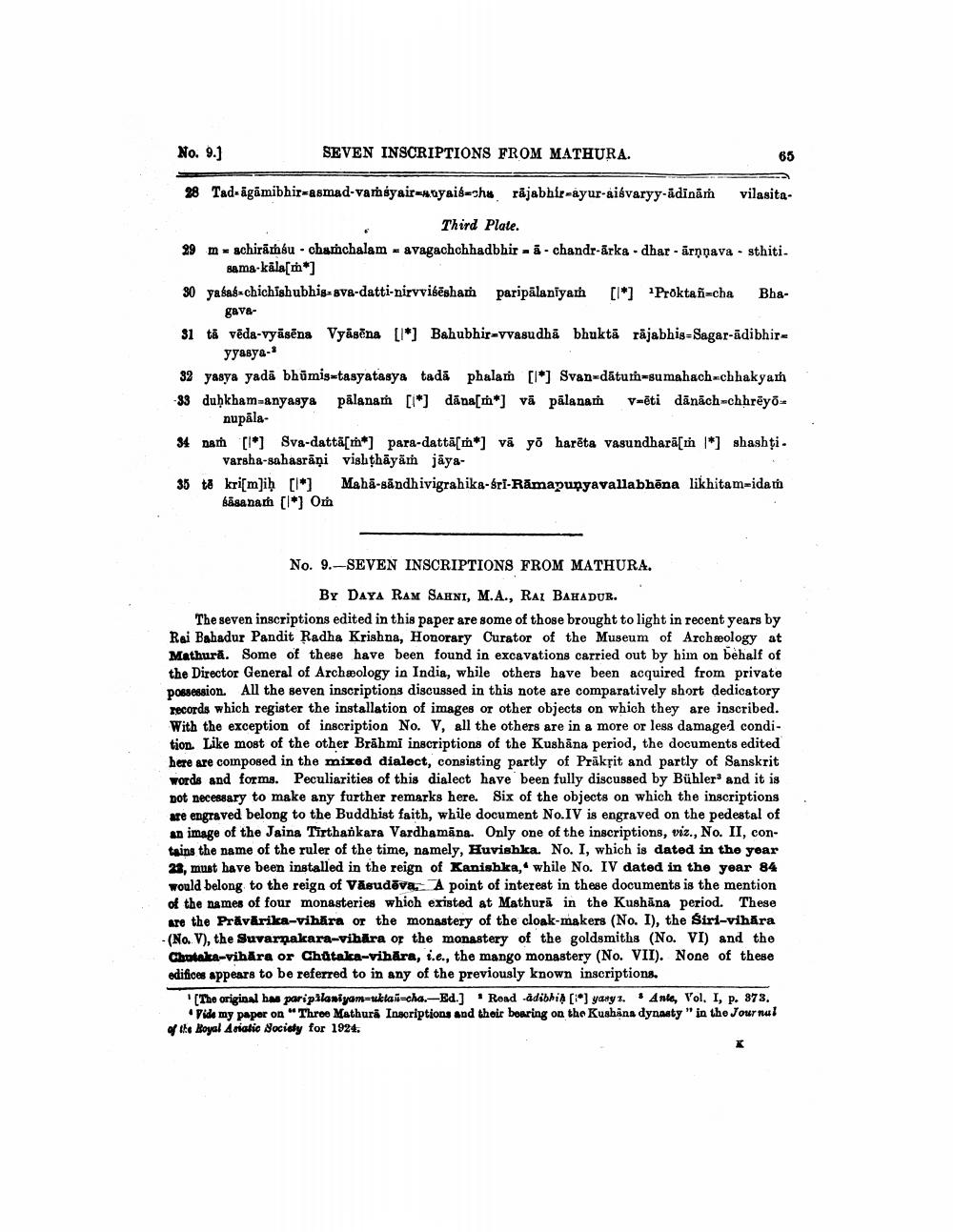________________
No. 9.]
SEVEN INSCRIPTIONS FROM MATHURA.
28 Tad-agamibhir-asmad-vamsyair-mayais-cha rajabhir-ayur-aiévaryy-ādinām
.
65
vilasita
Third Plate.
29 m achiramáu chamchalam avagachchhadbhir - a- chandr-arka - dhar - ārņpava sthiti.
*
sama-kala[m*]
30 yasas chichishubhis-sva-datti-nirvviéesham paripālaniyam [*] Proktañ-cha Bha
gava
31 tā vēda-vyāsēna Vyāsēna [*] Bahubhir-vvasudha bhuktā rājabhis-Sagar-ādibhir= yyasya
32 yasya yada bhumis-tasyatasya tada phalam [*] Svan-datum-sumahach-chhakyam 33 duḥkham-anyasya palanam [*] dāna[m*] vā palanam vēti dānāch-chhreyōnupāla
34 nam [*] Sva-datta[m*] para-datta[m*] va yō harēta vasundhara[*] shashți. varsha-sahasrāņi vishṭhāyām jāya
35 të kri[m]iḥ [*] Maha-sandhivigrahika-sri-Ramapunyavallabhēna likhitam-idam sasanamh [*] Om
No. 9. SEVEN INSCRIPTIONS FROM MATHURA.
BY DAYA RAM SAHNI, M.A., RAI BAHADUR.
The seven inscriptions edited in this paper are some of those brought to light in recent years by Rai Bahadur Pandit Radha Krishna, Honorary Curator of the Museum of Archæology at Mathura. Some of these have been found in excavations carried out by him on behalf of the Director General of Archæology in India, while others have been acquired from private possession. All the seven inscriptions discussed in this note are comparatively short dedicatory records which register the installation of images or other objects on which they are inscribed. With the exception of inscription No. V, all the others are in a more or less damaged condition. Like most of the other Brahmi inscriptions of the Kushana period, the documents edited here are composed in the mixed dialect, consisting partly of Prakrit and partly of Sanskrit words and forms. Peculiarities of this dialect have been fully discussed by Bühler3 and it is not necessary to make any further remarks here. Six of the objects on which the inscriptions are engraved belong to the Buddhist faith, while document No.IV is engraved on the pedestal of an image of the Jaina Tirthankara Vardhamana. Only one of the inscriptions, viz., No. II, contains the name of the ruler of the time, namely, Huvishka. No. I, which is dated in the year 23, must have been installed in the reign of Kanishka, while No. IV dated in the year 84 would belong to the reign of Vasudeva. A point of interest in these documents is the mention of the names of four monasteries which existed at Mathura in the Kushana period. These are the Prävärika-vihära or the monastery of the cloak-makers (No. I), the Siri-vihāra (No. V), the Suvarnakara-vihara or the monastery of the goldsmiths (No. VI) and the Chutaka-vihära or Chütaka-vihara, i.e., the mango monastery (No. VII). None of these edifices appears to be referred to in any of the previously known inscriptions.
[The original has paripilaniyam-ukta-cha.-Ed.]
Read adibhiḥ [*] yasy 1. Ante, Vol. I, p. 373. Fide my paper on "Three Mathura Inscriptions and their bearing on the Kushana dynasty" in the Journal of the Royal Asiatic Society for 1924.
K




